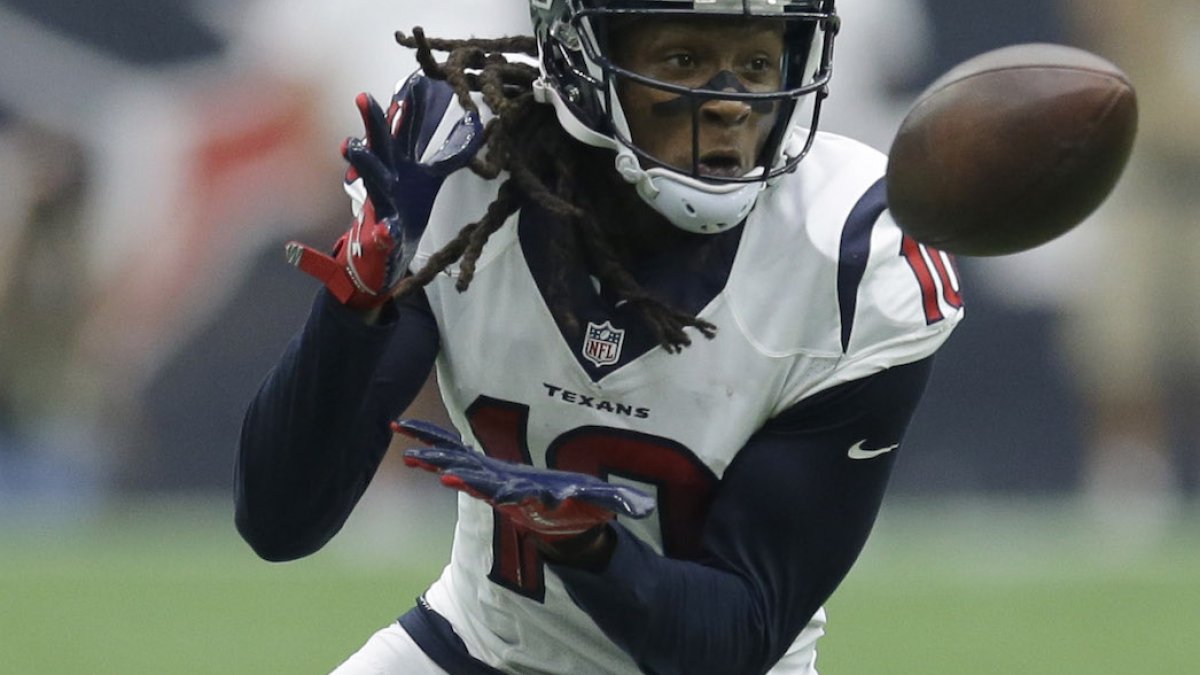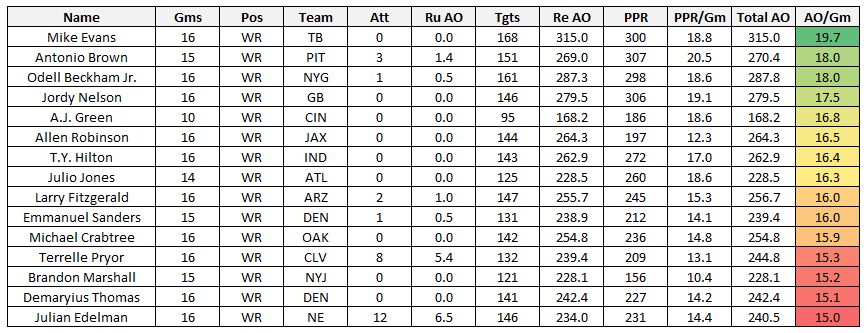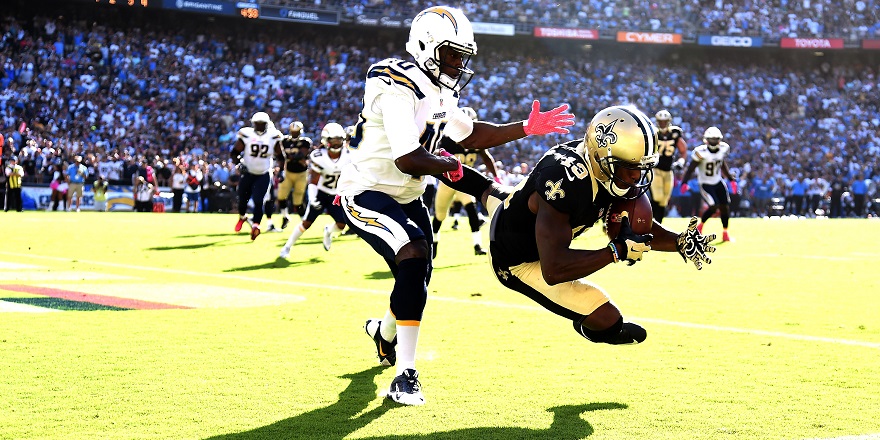Welcome to my new metric, “Actual Opportunity,” the overview of which you can find here. I highly suggest reading this before delving any deeper here. You can also find my writeup on running backs here.
Today, I will be taking an in-depth look at the wide receiver position through the lens of this (I’m hoping you agree) exciting new metric.
It seems fitting that in 2016, the summer of the “zero RB” draft strategy, we saw a major decline in wide receiver production. Wide receiver fantasy production hit an all-time high in 2015 and increased in 2016, but WR1 (top-12 fantasy wide receiver) production decreased by 450 total points, or roughly 14 percent. Perhaps this had something to do with teams running more plays with three or more wide receivers on the field at the same time, or maybe it was related to a higher rate of injuries at the position, or simply variance. Either way, the fantasy drop-off also mirrored itself in terms of opportunity. In 2015, we saw seven wide receivers total over 18.0 Actual Opportunity points per game, but we had only one such wide receiver in 2016.
See below for a list of the wide receivers who ranked in the top 15 from an Actual Opportunity per-game basis in 2016.
Notes: Players needed six games to qualify. All references to Actual Opportunity and fantasy points are in terms of PPR scoring.
Antonio Brown and Odell Beckham Jr. – Brown and Beckham finishing among the top three at the position should come as no surprise. They’re the only two wide receivers to rank top-three in Actual Opportunity per game in each of the last three seasons. Brown put up some historic numbers over his prior two seasons, finishing with two of the top-five highest-scoring fantasy seasons by a wide receiver all-time. His 2016 was a slight departure, finishing 63rd all-time in fantasy points (in 15 games). His 2016 season also saw him decline by more than two Actual Opportunity points per game over the average of the two prior seasons, though he was actually more efficient in 2016 on a per-target basis than in any year prior.
No wide receiver has ever averaged as many fantasy points per game over his first three NFL seasons as Beckham – and he paces the runner-up (Randy Moss) by more than two fantasy points per game. On a per-target basis, 2016 was his worst in terms of efficiency, but every Giants receiver (wide receiver and tight end) with at least 50 targets finished below expectation last season. Eli Manning’s declining play is a concern, but as it stands, Brown then Beckham are my preferred first two wide receivers off the board in 2017 drafts.
Mike Evans — Evans ranked first in Actual Opportunity per game last season, after finishing eighth in 2015. He led all wide receivers in air yards per game, finishing with more than 39 air yards per game over the next-closest receiver, Julio Jones. For perspective, this was a greater difference than between Jones and the wide receiver ranking 28th in air yards per game. Evans also led all wide receivers in targets per game and end-zone targets per game. In 2015 he ranked third in air yards per game, 10th in targets per game, but outside of the top-20 in end-zone targets, targets inside the 10-yard line, and targets inside the 20-yard line per game. Evans was basically the Buccaneers’ entire passing game in 2016, ranking first in the NFL in target market share, touchdown market share, and first-down market share. Tampa Bay got just five games out of Vincent Jackson this season, and were weak at depth behind him. After adding an elite deep threat and more than capable WR2 in DeSean Jackson, it’s safe to expect a significant decline in Actual Opportunity for Evans in 2017. However, he’s still very worthy of a mid-first-round selection in your drafts.
Michael Thomas and Brandin Cooks — Among all wide receivers to see at least 50 targets, Thomas ranked fourth-best and Cooks seventh-best in per-target efficiency. However, this likely has far more to do with Drew Brees’ proficiency as a passer than either wide receiver. This was the third consecutive season Brees has had two wide receivers ranking among the top-15 in per-target efficiency. This should also serve as an important distinction and reminder that when discussing a receiver’s efficiency we’re really saying “this quarterback when targeting this receiver was x efficient.”
Thomas and Cooks were essentially neck and neck in Actual Opportunity per game. Thomas bested Cooks in receiving Actual Opportunity per game, but when factoring in Cooks’ six rushing attempts, Cooks regained the lead in total Actual Opportunity by just 0.001 points per game. Had Cooks not been traded to New England, this could have been a fun debate – arguing who should have gone over the other in our fantasy drafts – but as it stands now, Thomas should be going several picks ahead of Cooks. The Saints appear to have replaced Cooks with Ted Ginn Jr., and both Ginn and Willie Snead appear to be undervalued in current drafts (less so for Snead after news of his three-game suspension came down). Following Julian Edelman’s season-ending ACL injury, 146 targets are now up for grabs in New England and will be dispersed primarily between Cooks, Chris Hogan, and Danny Amendola. Although Cooks’ current ADP has him in the early third round, I’m comfortable taking him in the second.
DeAndre Hopkins – In 2015, Hopkins totaled the second-most Actual Opportunity points of any wide receiver this past decade. That season, he led the league in air yards per game and ranked top-five in targets per game and end-zone targets per game. This season, he dropped a whopping 6.8 points in Actual Opportunity per game, finishing 16th at the position, and hit a career low in per-target efficiency. He dropped all the way to 14th in air yards per game and targets per game, and ranked outside of the top-35 in end-zone targets and targets inside the 10- and 20-yard lines per game. Hopkins was already due for a regression heading into 2016, but with Brock Osweiler’s deficiencies as a passer, and the ineptitude of the offense as a whole, he ended up as one of the year’s biggest draft busts. He’s due for some positive regression this season, but it’s hard to get too excited about his prospects with Tom Savage as the current starting quarterback.
Brandon Marshall and Allen Robinson – On a per-target basis, the three most inefficient wide receivers (in terms of actual opportunity over actual fantasy points) were (in order) Marshall, Jermaine Kearse, and Robinson. In terms of total Actual Opportunity points left on the table, Marshall and Robinson rank second- and third-worst of the past decade, respectively, with each scoring at least 65 points below their expectation. In 2015, Robinson ranked top-five in air yards, targets inside the 10-yard line, and targets inside the 20-yard line per game. In 2016, Robinson saw an only marginal decrease in every meaningful statistic, and actually saw a slight increase in targets per game. In terms of Actual Opportunity, he dropped only very slightly, finishing six Actual Opportunity points less than 2015. However, he declined immensely in efficiency, dropping by 106.7 fantasy points. Like Hopkins, Robinson should be due for some positive regression, but quarterback play is still a serious concern – as is head coach Doug Marrone’s desire to run the ball as much as possible in 2017.
Marshall, meanwhile, declined in both opportunity and efficiency, falling 83.7 points in Actual Opportunity and a whopping 187.4 points in fantasy points. Like with Robinson, we can try to explain away some of Marshall’s decline in efficiency by looking at quarterback play. In 2015, 72 percent of Marshall’s targets were deemed catchable by PFF. In 2016, that number dropped to 55 percent. That’s a massive difference, but there should still be concern regarding Marshall’s potential in 2017. Marshall is now 33 years old, and I highlighted earlier and elsewhere, Manning’s recent play has been concerning. Among all quarterbacks to play at least 60 percent of their team’s snaps, Manning has graded out as a bottom-five passer in each of the past two seasons.
Jordy Nelson, Davante Adams, and Randall Cobb — Last season, Nelson and Adams ranked top-seven among wide receivers in end-zone targets per game and targets inside the 10- and 20-yard lines per game. Green Bay was the third-most pass-heavy team in the red zone last season, but 22nd-most over the prior five seasons. With a better running game in 2017 and a healthy Cobb, we should expect Nelson and Adams’ Actual Opportunity scores to regress in 2017.
Even with a regression built in for 2017, I’m fine taking Nelson in the second round, despite the fact that he will also be turning 32 this season. In 2016, Nelson was the only wide receiver to finish top-10 on a per-game basis in terms of air yards, targets, targets inside the 10, red-zone targets, and end-zone targets. Emmanuel Sanders (perhaps somewhat surprisingly) was the only other wide receiver to rank top-10 in at least four of the aforementioned categories. In drafts, I’m mostly avoiding Adams in favor of Cobb, and hoping a healthy season from him means a return to fantasy WR2 form.
Doug Baldwin – Baldwin continues to be one of the more curious cases in this study, continually outperforming his expectation. In 2015, he ranked 41st in Actual Opportunity per game, but 16th in fantasy points per game. In 2016, he ranked 28th in Actual Opportunity per game, but 10th in fantasy points per game. He was the most efficient wide receiver on a per-target basis in 2015 and the fifth-most efficient on a per-target basis in 2016. Perhaps this has something to do with the fact that he’s the favorite receiver of Russell Wilson (who has been incredibly efficient in his own right). In his first four seasons in the NFL, Wilson ranked first, ninth, fifth, and fourth in PFF QB Rating. Still, Wilson greatly declined in efficiency in 2016, ranking 15th in PFF QB Rating in 2016, and Baldwin remained as one of the most efficient receivers in the league. We either need to accept Baldwin as being one of the most fantasy-efficient wide receivers in the game for years to come, or view this as a two-season outlier. I’m more inclined to believe it’s the former, but still will be unlikely to put him inside the top-10 wide receivers in my rankings due to a lack of target consistency.
Tyreek Hill — On the back of some insane efficiency numbers, Hill finished 49th in Actual Opportunity at the position, but 18th in fantasy scoring if we include his three special-teams touchdowns. Actual Opportunity currently does not incorporate special-teams work when calculating expected value, but even if we did, it would only add 2.68 expected fantasy points to Hill’s 2016 total. Hill averaged 0.73 fantasy points per opportunity last season, which was the highest of any wide receiver this past decade. This number and his differential (in terms of Actual Opportunity score versus fantasy points) is screaming at me that we should expect an efficiency regression closer to the mean in 2017, and I’m sure we will. That being said, I’m actually quite bullish on Hill’s potential in year two. Hill saw a decent workload in the second half of last season. From Weeks 9-17, Hill ranked 17th among wide receivers in Actual Opportunity, and 10th in fantasy points per game. Hill is currently being selected as the No. 19 wide receiver off the board in PPR leagues. Following Jeremy Maclin’s departure to Baltimore, an increase in opportunity should help balance some of Hill’s decline in efficiency. Even also considering Andy Reid’s disappointing WR1 numbers throughout his career, Hill is a fine upside selection in the fourth round of your drafts.
Julio Jones and T.Y. Hilton — Jones getting edged out by Hilton might come as another surprise – or, at least, it did to me. Both ranked top-six in air yards per game, and top-10 in targets per game. Jones actually beat out Hilton in targets inside the 10-yard-line per game and end zone targets per game. He did disappoint in the red-zone department, ranking 67th in red-zone targets per game, but Hilton’s ranking of 40th wasn’t much better. After doing a little digging, I found the likely culprit – and another reason why a statistic like “targets inside the x-yard-line” doesn’t always tell a full story. Looking at targets where the receiver was within 10 yards of the end zone at the point of the target, Hilton ranked 15th-best on a per-game basis, while Jones ranked a lowly 64th. Jones should be selected as the second or third wide receiver off the board in drafts, while I have Hilton in the late second round and slipping due to injury concerns surrounding Andrew Luck. As alluded to here, Jones' Actual Opportunity could take a massive step forward next season if Atlanta makes good on their promise to target him more heavily near the end zone.
Other – A.J. Green ranked fifth in Actual Opportunity per game last season, but was actually at a disadvantage given the fact that we’re looking at per-game numbers, as he only played two snaps in Week 11. If we removed that game from the equation, he would have ranked first among wide receivers in fantasy points per game and second in Actual Opportunity per game. He should be selected among the first four wide receivers in every draft you participate. … After playing in just three games in 2016, Eric Decker will be an intriguing bounce-back target in 2017. He ranked top-15 in Actual Opportunity in three of the previous four seasons. Few receivers are as dominant near the end zone as he is, and the Jets made a point to target him there as often as possible in 2015, when he ranked first in targets inside the 10- and 20-yard lines per game, and second in end-zone targets per game. Now paired with the league’s best red zone passer, Decker seems a strong value at ADP WR36. … Martavis Bryant should be intriguing as well. In 2015, on a per-game basis, he ranked top-15 among all wide receivers in air yards, targets inside the 10 and end-zone targets. Todd Haley has targeted his WR2s at one of the highest rates in the league over his play-calling career. Though currently being drafted two rounds later than Amari Cooper, Bryant blows him out of the water statistically. … Keenan Allen is another post-injury sleeper we have to consider. Allen ranked 10th in Actual Opportunity per game and fifth in fantasy points per game in 2015. He went into 2016 with a fat new contract, and saw seven targets on only 16 routes in Week 1 before leaving with a season-ending ACL injury. … Jarvis Landry saw a massive drop in Actual Opportunity in 2016, finishing 31st on a per-game basis after finishing 11th the season before. He lost over 2 targets per game as the Dolphins threw the ball 18.9 percent less often in 2016. With the emergence of Jay Ajayi and a less-conservative quarterback now under center (Jay Cutler), I don’t see that changing very much going forward. … Our wide receiver leader in Actual Opportunity per game in 2015, Alshon Jeffery, also saw a steep drop-off. Dealing again with injuries, and a PED suspension, Jeffery fell to just 18th in Actual Opportunity per game in 2016. He was also woefully inefficient on a per-target basis, mostly due to the fact that he converted just one of 21 end-zone targets into a touchdown. It’ll be interesting to see what kind of workload he receives in Philadelphia, but given three straight top-10 Actual Opportunity seasons from Jeffery (prior to 2016), I’m betting it’s significant. … Dez Bryant finished a shockingly low 24th among wide receivers in Actual Opportunity per game. His 13.6 Actual Opportunity points per game was his lowest total since 2011. He also hit four-year lows in targets per game, air yards per game, end-zone targets per game, and targets inside the 10-yard-line per game. While the Cowboys are still likely to be a run-first team, hopefully they become less conservative with Dak Prescott in year two. … Amari Cooper finished well behind Michael Crabtree in Actual Opportunity per game. Crabtree finished with 15 more targets than Cooper in 2016, and was much more heavily utilized near the end zone. This has been a common theme for these two receivers over the last two seasons. During this span, Crabtree has seen 24 targets within 15 yards of the end zone (leads the team), while Cooper has seen just 12 (also behind both Seth Roberts and Clive Walford). Cooper is someone I’ve been avoiding at current ADP (WR9).





 © 2025 PFF - all rights reserved.
© 2025 PFF - all rights reserved.